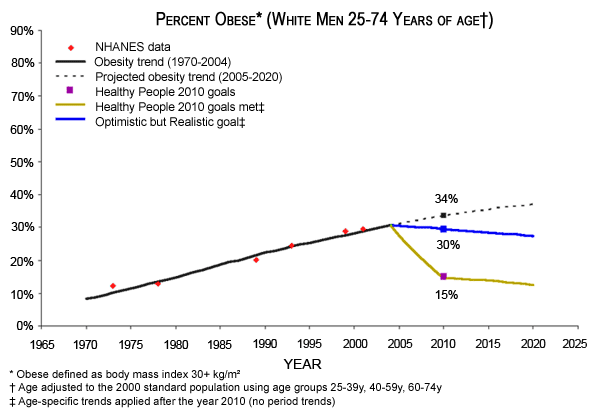Projection Scenarios for Colorectal Cancer
Summary: learn what “optimistic but realistic” and “Healthy People 2010 goals met” mean
Scenarios refer to a set of assumptions about future trends in factors that affect colorectal cancer (CRC) mortality. We ran simulations multiple times, each time varying our assumptions about these future trends. You can see and compare the results from various model runs in the Interactive Graphs section.
We used three basic sets of assumptions, which we call "scenarios." Our scenarios are:
- Projected Trend (the baseline): rate of change of all inputs continues at the same pace as from 1970-2004. Note that it may be difficult to keep up the pace of improvement in some areas.
- Optimistic but Realistic: values for all inputs improve over the projected trend – how much depends on our best informed guess as to what is realistic yet still a stretch, specific to each race/gender group. We used various approaches for setting these goals – bettering projected trends by a small amount, examining analogous experience in other areas, and studying the literature for indications of upper limits.
- Healthy People 2010 Goals Met: values of all inputs improve to applicable Healthy People 2010 (HP 2010) objectives by 2010 and continue at the same rate as projected trends after that. Inputs with no applicable Healthy People objectives continue at projected trends rates. The risk factor and screening targets (there are no HP 2010 objectives for chemotherapy) that we used are listed in Healthy People 2010 Goals. Note that HP 2010 goals are set for the population as a whole, and may be more difficult to meet for some race/gender subgroups than for others.
By changing some assumptions while holding others at baseline values we isolate the effect of changes in risk factors, screening and chemotherapy. To evaluate risk factors under the Optimistic but Realistic scenario, for example, we ran our simulations with Optimistic but Realistic values for risk factor inputs and Projected Trends (baseline) values for all other inputs. We did the same with Healthy People 2010 Goals Met values, and for screening and chemotherapy. Altogether, we ran the simulations 11 times for each race and gender subgroup.
Scenario Details
The computer simulations upon which these projections are based take input parameters for various interventions. The model needs values for the percentage of the population who smoke, are overweight, have a CRC screening test, etc. over time. For simulated patients with diagnosed cancer, parameters determine whether they receive chemotherapy, and, if so, what regimen. For more information on how the simulations work, see Simulation Models; for a list of parameters, see the sections on Risk Factors, Screening, and Chemotherapy.
Our interest is in seeing how changes in upstream objectives affect CRC mortality rates. For that reason, we need a baseline from which to measure change. For our baseline, we projected values year by year for each upstream objective based on recent history. For example, to determine what percentage of our simulated population should be obese, we examined the NHANES data (the red dots below, see References and Data Sources for more about the survey) and projected the trend out to 2020 (dotted line below).
 [D]
[D]
By doing this for each upstream factor, and then running a simulation with those inputs, we arrived at the baseline, which we call "Projected Trends."
We initially set out to evaluate the potential effects of meeting Healthy People 2010 goals, and we calculated inputs that would achieve relevant Healthy People objectives by 2010. These inputs make up the "Healthy People 2010 Goals Met" scenario.
However, when you look at the graph above, you see that the target of 15% obese (the purple square on the graph) is unlikely to be achieved, at least for white males, given that the current value is about 30% and the trend is in the wrong direction (and it doesn’t look any better for other demographic groups). Therefore, we felt a need to set group-specific targets that would be achievable, but only with concerted effort (the blue line above). These objectives we termed “Optimistic but Realistic” goals. In some cases, such as screening, Optimistic but Realistic goals better the corresponding Healthy People 2010 objective.
We then ran the simulation multiple times for each sex and race combination. For each run, we used Projected Trend inputs as a baseline, setting specific groups of measures to Optimistic or Healthy People 2010 goal levels. For example, to understand the contribution of risk factors to overall cancer mortality, we ran simulations with screening and chemotherapy at Projected Trend levels and risk factors at Optimistic or Healthy People 2010 levels. We also ran simulations where combinations of measures were set to Optimistic or Healthy People levels.
These is no guarantee that improvements will continue at the current pace; our projected trends line may be overly optimistic. But that would only change the absolute magnitudes of other changes, not their relative differences.
Example Scenario Comparisons
Simulation runs can be compared using the interactive graphs.
When you compare intervention scenarios using the interactive graphs, you see two views of the results. You can directly compare the impact of two or more interventions (the bar chart on the right below), or you can compare the projected mortality through 2020 of those interventions (the line graph on the left). In this example, you can see that Optimistic but Realistic assumptions for screening alone (red bar) account for most of the potential additional mortality reduction, beyond that predicted by current trends, from risk factor, screening and chemotherapy interventions combined (the blue bar). On the left, you see the projected age-adjusted mortality rate for the baseline (the black circle line) and the optimistic assumptions about screening (red triangle line) and combined interventions (blue square line).
You can also compare results for different race and sex combinations, or look at the differences between the two models.

